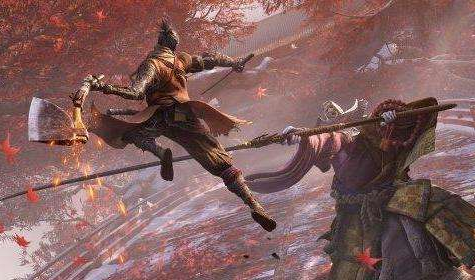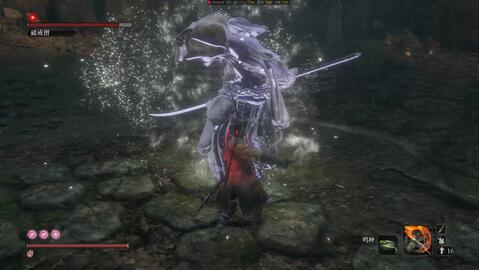In the game, we need to fight two battles with the Sekiro Monk, but during the battle, many players discovered that the boss made a sound like a woman when he was attacked. Let’s take a detailed look at the true identity of the Sekiro Monk. Take a look.
Detailed analysis of the true identity of the monk who broke the precepts

Eight hundred bhikshuni, eight hundred refers to her eight hundred years of life, and bhikshuni refers to her profession, that is, a nun. The original legend of the Eight Hundred Bhikshunis cannot be verified, but a widely circulated version records: It is said that a man was invited by a stranger to a strange place, and that place was similar to the Dragon Palace, where the man found a mermaid meat. The man felt disgusted and did not eat the food, but took it away as a souvenir. After taking it home, his daughter ate the mermaid meat. In this way, his daughter gained the ability to live forever. In her long life, she saw through the mortal world and became a monk and became a bhikshuni. When she was eight hundred years old, she went into a cave alone and died of hunger strike.
In the official version of the game, the first time you see the broken monk is in front of the cave in Shuisheng Village, guarding the cave. This aquatic village cave also corresponds to the legendary place where eight hundred bhikkhunis went on a hunger strike. But unlike the legend, she did not die but went to the hometown of the source. As mentioned earlier, the father of the Eight Hundred Bhikkhunis obtained mermaid meat from a place like the Dragon Palace, and the buildings in the Land of Origin, the Fish King, the nobles, the Sakura Dragon, etc. also show that part of its prototype came from the Dragon Palace. At the same time, the need to be able to breathe in water to get on the sedan chair to the hometown of the source also proves this statement.
The weapon used by the eight hundred nuns is the naginata. In ancient Japan, it was a weapon used by monk soldiers. After the size of the weapon blade was limited, it became lighter and became a weapon used by women. The mask worn by the eight hundred bhikkhunis is "Yaksha". Yaksha was originally a ghost and god in Indian mythology. When it spread to Japan and other places, it became the general name of ghosts and gods.
The image of wearing a white horned mask, holding a naginata, and wearing a cloth on his head is a typical image in Noh drama. In Noh drama, there happens to be another classic image that corresponds to the broken monk guarding the bridge in the hometown of Minamoto, and that is the monk soldier under Ushiwakamaru, Musashibo Benkei. The place where Ushiwakamaru and Musashibo Benkei met and fought for the first time was on the bridge, and the monks and naginata weapons also corresponded one to one. The mask he wears is that of "Prajna" in Noh drama.

Prajna is originally a Buddhist term in Buddhism, referring to great wisdom. Prajna in the widely circulated Prajna Paramita is one of its applications. There are two theories about the origin of "Hannya" in Japan. One is that the maker of the mask was a monk and the production place was Prajnabo. The other is that a ghost possessed by jealousy in "The Tale of Genji" The woman studied the Prajna Sutra to eliminate the evil spirits, and the mask condensed after that was called "White Prajna". Nowadays, the prajna in Japanese folk tales inherits the setting of the second origin. They are evil spirits formed by women's strong jealousy and resentment.
Speaking of jealous monsters and bridges, I wonder if you have thought of a certain green-eyed jealous monster, Hashihime. Hashihime's story is equally complex, and although accounts vary, she appears in most stories as a jealous god. And I found this saying: Watanabe Tsuna, one of the Four Heavenly Kings under Minamoto no Yorimitsu, once cut off a hand of the "ghost of jealousy" on a bridge, and the ghost looked like a beautiful woman, and then he With the legend of Hashihime. In the subsequent evolution of this story, the nameless ghost of jealousy was replaced by Ibaraki Doji. The sword used by Watanabe Tsuna was a sword given to him by Minamoto Yorimitsu, named Hashi-kiri, and he used this sword to cut off Oni's arm and the name of the sword was changed to Onikiri. The hidden BOSS, the ghost of resentment transformed by the Buddha Carver who lost an arm, corresponds to Ibaraki Doji. In other words, the Immortal Sword possessed by the wolf is the Hidden Killer, and the Black Immortal Slash is the Knee-Kiri paired with the Hidden Killer. Its other name is Doji Kiri Yasutsuna, who is famous for killing Shuten Doji. .
The topic returns to the Ring-breaking Monk. Her story with Immortal Slash is not over yet. Her moves from the appearance to the second stage are all related to Maple Leaf, and there is such a Red Leaf Ghost who has another story with Onikiri. According to records in Japanese history books, Taira Nomomo defeated a group of thieves disguised as female ghosts at Togakushiyama in Shinano Province in 969, the second year of Emperor Reizen's reign. 》. At this time, it was only stated that Ping Wei Mao received the divine sword and killed the evil spirits, but the name of the divine sword was not stated. In the subsequent development, there was an important turning point, and that was "Hokumuyama Ryouki Chronicles Togakusayama Ghost Girl Momiji Retreats". This revision is very different from the previous legend. Hongye has become the reincarnation of the Sixth Heavenly Demon King, and the previously nameless divine sword has been given the name of a famous sword, and it is Onikiri.
The above is the complete analysis of the true identity of Sekiro, the monk who broke the precepts. I wonder if everyone agrees with this statement?